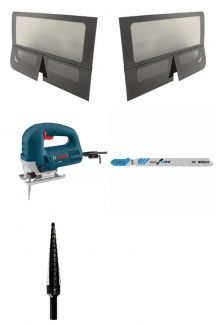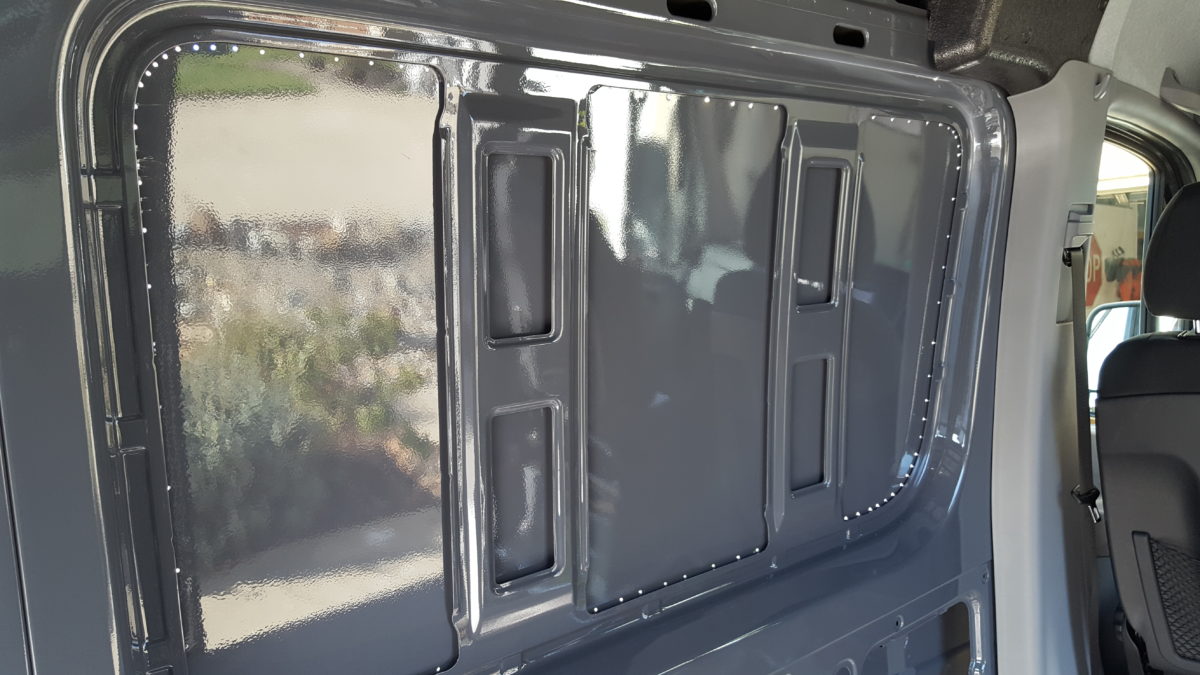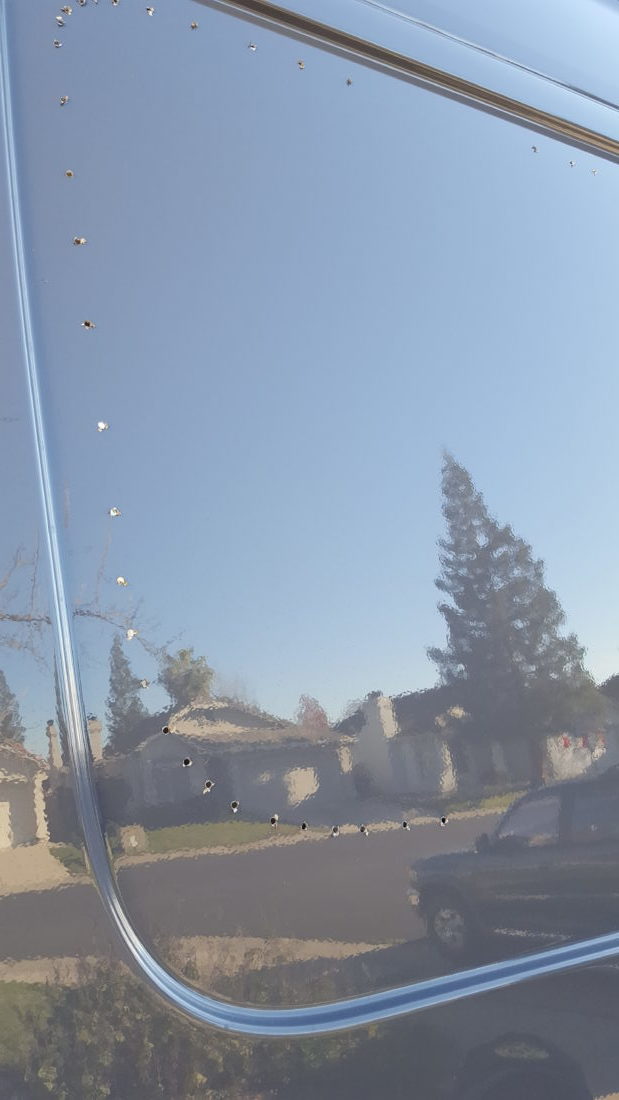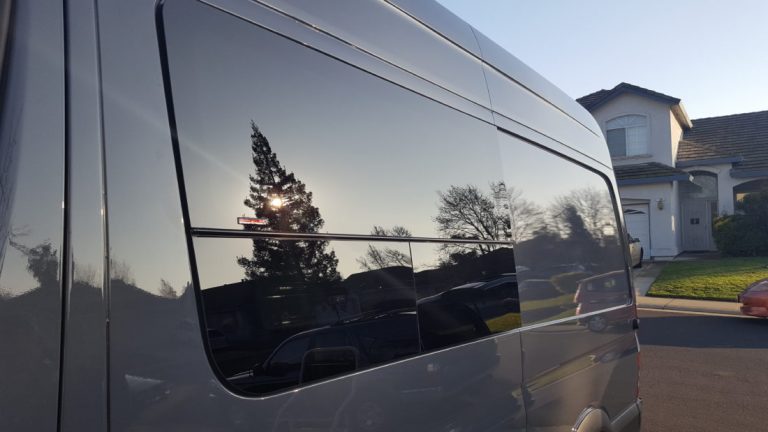Installing Aftermarket Windows
Installing CR Laurence T-vent Windows

Installing windows is sort of a rite-of-passage for building a van. Our van had 46 miles on the odometer when we cut open the side to install our first window. Windows not only add ventilation but fundamentally change the experience by bringing the sunlight and the outdoors into your van. In this write up we install a CR Laurence T-vent window into the side of our cargo van.
There are three brands we recommend including (1) CR Laurence (2) AM Auto, and (3) Arctic Tern. Our CR Laurence windows have been installed since December 2016 with no issues. Each CR Laurence window is listed below. Both the CR Laurence and AM Auto windows will install in a similar fashion. The Arctic Tern are not cut to fit any specific van and do not conform to the body lines of the van like the other two windows. What they bring to the table is double pane acrylic construction and integrated screens and window shades.
Note: This site contains affiliate links for which I may be compensated.
Sprinter CR Laurence Windows (for all 2007-current):
- Driver Side Forward T-Vent Window (144 or 170)
- Passenger Side Sliding Door T-Vent Window (144 or 170)
- 170-Only Driver Side FIXED Middle Window
- 170-Only Passenger Side FIXED Middle Window
- 170-only Driver Side Rear T-Vent Window
- 170-Only Passenger Side Rear T-Vent Window
- 144-Only Driver Side Rear T-Vent Window
- 144-Only Passenger Side FIXED Window*
*T-Vent not available for 144 passenger side REAR due to conflict with sliding door
Ram ProMaster CR Laurence Windows
Ford Transit CR Laurence Windows
Tools required:
- drill & drill bits
- step bit
- jigsaw with fine metal blade
- foam or bristle paint brush
- plastic drop-cloths
- blue painter’s tape
- oil-based paint
Have you seen the T-Vent Window install video on YouTube?
Preparation for CR Laurence T-Vent Window
Before doing anything, unbox your window and ensure that the item arrived undamaged and all mounting parts are present. I would go so far as to pick up the clamp ring and make sure it matches the contour of the vehicle. We are just ensuring we got the correct window before we cut.
Protecting Your Investment
Let’s talk about swarf. Swarf are the metal shavings coming from your drilling and cutting and you do not want them in your wall cavities! These metal pieces will drop into the confines of your wall panels and start causing rust within days. I can’t stress this point enough in your build, tape off the wall panel using blue painter’s tape and plastic drop cloths to control the drill swarf.
Sprinters have a Built-in Template!
Going inside the van you will find that the sheetmetal is single-walled where windows are installed and then transition to a double wall for strength. The transition between the single wall and the double wall is where we want to cut. That can be seen in the photo below. As you may guess, the best way to translate the cut-line from the inside to the outside of the van is to drill small holes through the sheetmetal using a small drill bit. Follow the contour between the single and double wall as your template, but don’t drill into the double-walled section.
With that scary procedure done, let’s see how it now looks on the outside.
Protecting the Exterior Paint
We now want to protect the exterior paint of the vehicle from being scratched by the shoe of the jigsaw. Tape to the outside of your drill mark line, being sure that it’s at least as wide as the shoe of your jigsaw. We are using 1″ wide tape and had to use two widths of it for coverage…it would be better to use 2″ or 3″ blue tape.
Creating an Access Hole for the Jigsaw
Now drill a new hole about a half inch inboard from your existing holes. When we say “inboard,” we are referring to an area within the sheetmetal you will be cutting out. Then use a step bit to enlarge this hole so it is large enough for the jigsaw blade to get started. We recommend a step bit because once you go up in drill bit size, it will want to grab on to the sheetmetal and produce a dimple. A step bit makes a nice round hole without drama.
Making the Big Cut
This sounds all too easy, but now you just need to insert the blade of the jigsaw in the hole we just drilled and connect the dots. Ours made a clean cut with the fine metal blade. Don’t worry about trying to remove the internal bracing first, the jigsaw will cut through it like it’s not even there.
With any luck you have a hole that looks like this, but hopefully you have someone better looking to model the giant new hole in your van.

Smoothing and Painting the Cut
At this point you may have a few rough points from your cut, or maybe you got a bit conservative and need to remove a little material to bring it up to the level of the internal flange, because that is our goal. If this is the case, you can use a flap disc on a cheap angle grinder (ours is a cheapy from Harbor Freight) to remove excess material. Use oil-based paint and either a foam brush or a hobby brush to paint the exposed steel. This is to protect the area from rust. You can now remove the blue tape.
CR Laurence T-Vent Window Installation
Installing the Glass
Now the part you’ve been waiting for, installing the glass. You will need the help of a friend. Get your Phillip’s head screwdriver, the installation screws and clamp ring, and bring them inside and within easy reach. Set the window face-down on it’s cardboard box near the window opening. Once the paint is dry, spray the perimeter of the window opening with water, and spray the gasket of the window as well. This will help bed the gasket on the van without undue friction. Have your friend lift the window in place and hold pressure against it so it does not fall out. You will be putting pressure on the window from the inside when you start screwing it into place.
Installing the CR Laurence Window Trim Ring
Fit the trim ring around the window with the split in the flange pointing down. We set all of the screws lightly and tightened them all down, but a better method is to start by installing a screw at the split in the trim ring and slowly work your way around in either a clockwise or counter-clockwise direction, ending at the other side of the split in the trim. This method will result in a tighter gap at the trim ring split than the method we used. We used this latter method when installing the half-slider windows in the rear of our van. Keep going around in this fashion until all screws are tight.

Help Us Help You
We offer all of our write-ups and instructional videos for free. A lot of time, effort and money goes into developing and maintaining this website. If you find the information on this website helpful, you may use our various links when you are ready to make purchases. As Amazon Associates we will make earnings from qualifying purchases, however it costs you nothing to use them. Alternatively you may consider using the donate button below to make a simple Paypal payment, or message us if you prefer Venmo. We sincerely appreciate your visit as well as your support.
Final Window Fitting & Adjustment
These windows are not a 100% absolutely perfect fit. They seemed to be curved just very slightly less than the side of the van, so if you notice it being less flush than the factory windows, it’s not just you. That said, I found that when I came back later and gave the screws another turn, it sucked the window in a bit more and overall fitment is pretty good.
We have found these screened windows really help in creating a draft in the van, when used in conjunction with the roof vent fan. We typically run our fan in reverse (pulling air out), with the t-vent window wings open. Without some kind of opening in the van, there really isn’t anywhere for the air to go.
Thanks for reading along and good luck with your window install!






Hi Ken! Currently ordering a van, and was wondering how your felt that your window configuration was working out. In speaking to the sales rep, apparently if you want vented windows you’re better off cutting the holes yourself than removing glue from the factory installed windows. He suggested a solid window in the slider (as you seem to have), and no window behind the driver (so the CR Laurence can be installed). How do you feel this configuration is working out for you? Do you wish you had the vents in the door? Do you wish you had just gone solid on the driver side and skipped the hassle?
Thanks!
Hi Christian, I had heard the exact same thing about cutting the hole yourself as opposed to trying to deal with the factory glass and adhesive. I am really happy I went the route I did, which is factory glass in the rear doors and in the sliding door, and none behind the driver. It’s nice to be able to open the t-vent window in that location and get a breeze moving the length of the van. Doing it all over again I would go exactly the same route.
Thanks! I neglected to mention that the sales rep also mentioned that the vent window on the slider can facilitate break-ins. So all things being equal on which side to go with the vent window, it would seem that the driver side would be the one to go with, at least from that anecdotal evidence. =)
Thanks!
Great review and install of the window. Once question I had is can the vent be open while driving? Or are they only to be opened when parked
Generally I think it’s probably advisable not to. I would think it would be hard on the adjuster mechanism.
Very informative article. Thanks a lot for sharing.
Hi Ken, You relay didn’t need any clue like (Auto Glass Urethane Adhesive) to set the window in.
Hi, I’m assuming this was a question but no, none is recommended or needed. There’s a rubber gasket that goes around the window frame to keep it leak-free.
Hi Ken,
First thank you vey much for your videos. They are very extremely informative and very pleasant to watch. I am planing on installing CR Laurence windows: with T Vents on the driver side and glass only in the sliding door. You seem really happy with the ventilation in your van. If you had to install a window in the sliding door because there was none, would you still select a glass panel only? I am leaning towards this choice for safety reason as I have heard that a T vent window in the sliding door might encourage break ins. It’s too bad. Could always use more ventilation. I am also installing 2 bunk bed windows, with sliders, also for ventilation. I wonder if you could share your thoughts about sliders versus T vents. I have been discouraged to install Vents because they “do not open well enough to provide ventilation.” What is the brand of your bunk windows? Finally, where do you think the ceiling Maxx Air fan should be installed to provide the most optimum results? I am working on my final solar panel layout ( a whole other conversation…….) and the fan needs its spot
Thank you so much !!!!
Hi Valerie,
I ordered my van from the factory with fixed glass in the slider for all of the reasons you mentioned. I added the T-vent on the driver’s side and also have the Hehr 10×36″ windows I bought from RB Components. I have plenty of ventilation. In my opinion it’s not about the size of the screened opening–the best airflow I can get is to have the maxxair in reverse mode with ONLY the forward-most T-vent window open a couple of inches. That creates a path of moving air that goes as far as possible through the van and over my bed before leaving through the fan near the rear of the van. If I open a rear bunk window it’s only exchanging the air between the window and the fan. But keep in mind this would work great if you have a high-mount bed–my bed is in the middle of the van and lower in height. Maxxair should be as close to your bed as possible and if you have the room install two Maxxair fans. I didn’t have the room for two as solar was a priority for me. I hope that helps and thanks for visiting! -Ken
You used no glue? No sikaflex or anything?
If not did it seal? Does it drip when it rains?
No glue, the window uses a rubber gasket. Never a leak.
Step Bit! For the win!
Kookz! For sure, I didn’t even know they existed until I started my van build. Now I use them all the time, particularly good for sheet metal. -Ken
Well done! Was wondering how you’re still liking your CRL windows now that you have had them installed for a while? Been considering these T vent windows or a slider like AMA windows. Thanks in advance!
Hi, I really like their function, being able to use them when it’s raining and having the screens is nice. That said the quality control isn’t the best, however I would still choose them today as I feel the sliding windows would limit my use a bit.
Okay great to hear thanks!
Great info thanks, I was just wondering if you could see any issues fitting these windows to a right hand drive vehicle? Maybe the double vent and the sliding door catch, yes/no?
Hmm, that’s a good question. I can’t confirm if a US sliding door window will work on the other side due to the shape.